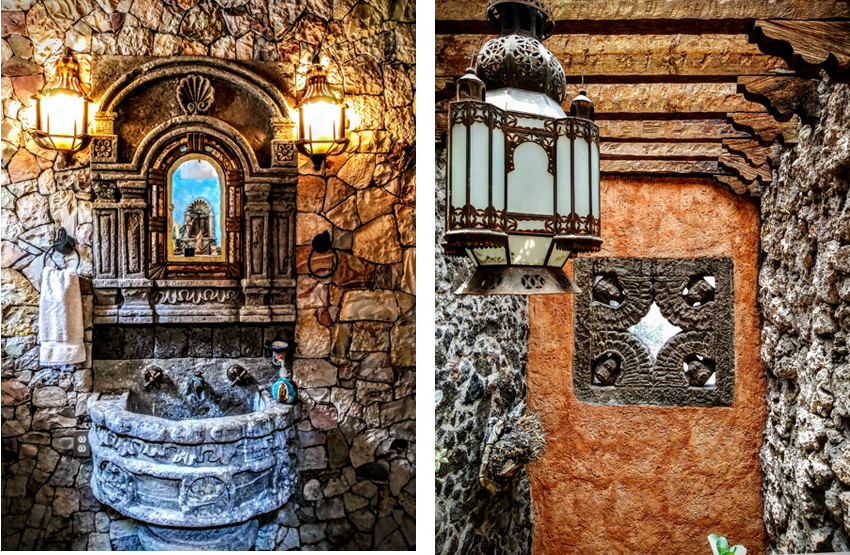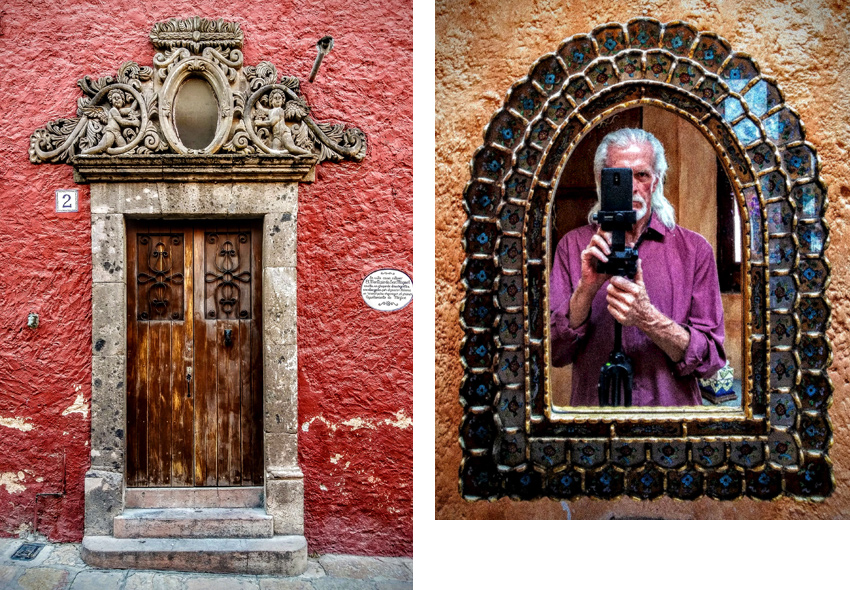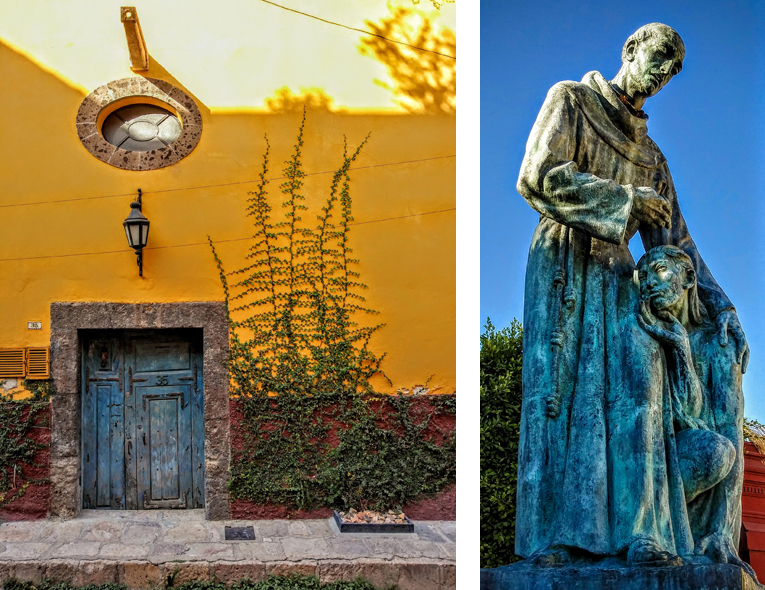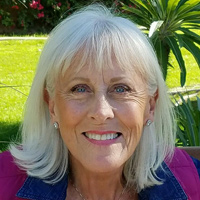
by Pam Walters
I have to admit that when I first contacted local photographer Jon Welsh for an interview, I intended to have some fun with him, at his expense. Jon frequently posts photos on SMA’s Civil List. These shots, taken on his morning strolls, are of facades of buildings: doors, windows, the occasional tree or flowering plant that might be affixed to a building. The images are exquisite.
But here’s the thing, the thumbnail photo of him that identifies his posts is… well… of a gorgeous older guy with a smoldering look on his face. Be still my heart. Then I noticed that I wasn’t the only female bewitched by his photography and his picture. It seems that 90% of his followers are women oohing and aahing over the images. I thought of the old “hot photographer” syndrome.
The chip on my shoulder about photographers dates back to my early years as an ad agency creative director. Back then creative people worked in teams. I was the copywriter. Copywriters were primarily female and dressed conservatively. Copywriters were partnered with an art director. This role was usually played by a guy. We’d collaborate on most aspects of TV and print production, but the copywriter usually took the lead when it came to music, and the art director was in charge of visuals – including working with photographers.
Photographers were an elusive bunch, ultra cool in attitude, usually hot-looking with their perfect length of facial hair stubble, ponytail and black uniform; kind of like Palladin, but instead packing a six-shooter, he’s carrying a long, heavy lens. And much to my chagrin, cool-types like that never took a second look at someone like me, dressed in my standard, gray Armani suit.
As a bit of background, the two-person team approach was the way it was done at big agencies until the ‘90s. That’s when everything seemed to change. There was a shift from words/concepts to big visuals. Large, colorful photos of the client’s product with a headline that screamed something like “SALE… 50% OFF.” It doesn’t take Mark Twain to write that kind of copy.


That’s pretty much what’s still happening today. When someone asks me to help them with their advertising or marketing, they’re really only looking for a person who can do graphics,n ad or a flyer. That’s why copywriters are a dying breed. Today’s art directors insist that the client doesn’t need to hire a copywriter; they can do it all. Another big harrumph from me.
So, armed with years of old resentments, I was going to confront Jon Welsh for being a superficial person who enjoys basking in the sunlight of all the praise he gets from his female admirers.
But then, within five minutes of talking with him, I was completely disarmed. Jon is one of the most self-effacing, kind, sensitive, gracious men I’ve ever met. And that “smoldering look?” That’s actually what he looks like.
What’s more, Jon is very happily married and has a 17 year-old daughter. He walks Kate to school each day. And while he waits for her – from 8am to 9am – he takes his morning stroll and does his photography.

“Are you aware that about 90% of your Civil List fans are women who seem to have the hots for you?”
“Well, my wife, Erika, and daughter, Kate, do poke fun at me from time to time about the posts. If anything, I’m a little embarrassed by the attention. And, frankly, a bit pissed off by it as well,” he said.
Jon explained that when he was little, he had to wear coke-bottle eyeglasses. He was called “four eyes” and endured the usual insensitive crap from his classmates until his mid-teens, when he was finally able to get contact lenses strong enough for his poor eyesight. Suddenly, his life was different.
“I hadn’t changed, but immediately I was ‘accepted.’ In fact, I was in demand.” The fact that he became popular because of his good looks annoys him to this day. I quickly shut my mouth on the subject.
When I asked him how long he’s been photographing, he said that his dad gave him a camera when he was six. By eight, he was in the darkroom developing his images. At 15, he was doing color darkroom work for college students and professional photographers. He found his calling early in life. Lucky guy. (Or maybe we each sense a calling early on, but many of us don’t have the determination to follow it.)
During his career, he became quite successful not only for his photographic work, but, eventually, also on the post-production side of the industry. He operated two commercial photo labs, two commercial studios, one portrait studio and opened a chain of 30-minute photofinishing shops.


But before I go into more detail about his technical abilities, I want to concentrate on why he became such an over-achiever. Was it simply because he was the oldest of his two siblings, or is there something more subtle yet powerful driving his desire to communicate with people through visuals?
Does his drive and talent stem from the fact that, as a child, Jon grew up in a “deaf” home? He and his siblings can hear, but both of Jon’s parents were deaf. His mother lost her hearing around five from polio. His dad lost his hearing as an infant from scarlet fever.
He didn’t have the usual verbal foundation. No Mama, Papa. No apple. No coochie-coos. He learned to speak at a fairly normal age… but no one has ever been able to decisively explain why.
“At five, I was making all the phone calls for my parents. In fact, when the phone company came to install the phone, they had to mount it low on the wall so I could reach it.”
Jon’s dad was quite successful in the printing and prepress (AKA post-production)industry. Back then, printing was considered to be one of the top two ways to earn a good wage as a deaf person – the other occupation being carpentry – and so these subjects were heavily emphasized in schools for the deaf.

At home, his parents signed. Out in public – while his dad was perfectly comfortable signing, it embarrassed his mother. Lip-reading became her way to understand people. It rubbed off on Jon. To this day, Jon has difficulty “hearing” people unless he can watch their lips as they speak. And, he also has a habit of non-verbal communicating. Jon says he doesn’t think in words; he thinks visually.
“I’ll tap someone on the shoulder and point in the direction of what I want them to see. Some people find it annoying.”
There was no TV or radio at home. The family didn’t sit around the dinner table, discussing politics or sports or entertainment. In fact, Jon didn’t hear music on a radio until he was 12, at a friend’s house. The first song he ever heard was the Beatles’ “I Wanna Hold Your Hand.” And all these years later, that song remains chiseled into his brain. He hears it all the time.
“Imagine having to listen to that song all your life!” he laughed.
But once he was exposed to music, he became your typical teenage guy and liked to play his music as loud as he could. He could get away with it. The bass was so powerful, his mother said she could feel the vibrations through the floor. And she enjoyed it; she danced to it.
Geographically, as a child, Jon’s family moved from Utah, where he was born, to Colorado Springs for his dad’s work. Jon loved everything about Colorado, so when he was several years older – a teenager – and his family decided to move back to Utah, Jon wasn’t at all happy. He had to pick himself up out of high school and get relocated into a new school with all new friends. Of course, his love for photography was a constant in his life.


Now to his adult, personal and professional life. He shot film for his personal work until the mid-‘90s, but, for the most part, he had already switched to digital as soon as it came out in the mid-‘80s. By the late ‘80s he was building custom, Macintosh-based workstations. He was one of the first non-programmers to work with Photoshop as a beta tester. In fact, he helped Adobe write their manual for Version 1.
During the early ‘90s He was heavily involved in a start-up in the then-nascent grand-format digital printing industry (think billboards). In addition to selling and installing his custom workstations around the world, he provided advanced color theory and “prepress” classes to corporate clients in some 20 countries to ensure that the images printed on these new 16-foot wide (5 meters) inkjet printers were of superior quality.
By the late ‘90s he had settled down in a small town west of L.A. He spent the next 15 years doing graphic design, prepress, consulting and large-format and billboard production work, primarily for the motion picture industry.
Fast forward to today – and his simpler life here in SMA – he’s been shooting his photos with his cell phone.

“It’s an LG and relatively inexpensive,” he says. “But I love the shots I get.”
He also does some minor enhancing right on his phone. He doesn’t do a lot of post-work; just enough to try to capture everything he initially saw when taking his shot. He strives to regain all the detail that a camera phone – or most regular cameras for that matter – just can’t get.
So, while he’s waiting to replace his “real” camera, which went missing shortly after he arrived in SMA last summer, he says it’s actually been quite liberating to be able to just wander around with his cell phone.
In wrapping up our conversation, Jon said, “I don’t usually shoot people. I shoot what people make… architecture, art, even food.” And, again, I wonder if this step back from person-to-person intimacy might not be another aspect of his childhood?
As for the future of photography, Jon sees people viewing photographs using VR goggles. While the goggle technology isn’t adequate yet, Jon believes that people will soon be able to ‘step into a photograph’ for a fully immersive, 360 degree view. Hard to imagine, but then we couldn’t believe our eyes when the big IMAX theaters opened many years ago. He also mentioned that he likes the idea of using an 8K television display as a wall frame, since it can reproduce nearly the full, dynamic range that the human eye can see, which a paper print cannot do. Apparently, you lose about 95% of an image’s dynamic range when you put it on paper.
For now, Jon is very content here in SMA, shooting images with his cell phone, posting occasionally on Civil List and walking Kate to school every day. A simple life for a major talent.
**************

Pam Walters is a resident of San Miguel de Allende. Her poetry and prose have been published in The Southampton Review, Chicago Literati, Switchback, Cutthroat, Cutbank literary reviews and Round-Up Writer's Zine. Seven of the chapters from her memoir, "I Hope Prince Charming Drinks," have been published in literary journals. She's won writing competitions for memoir and humor. Two of the chapters from her book were performed live. She recently won for non-fiction at the San Miguel International Writer's Conference.
|